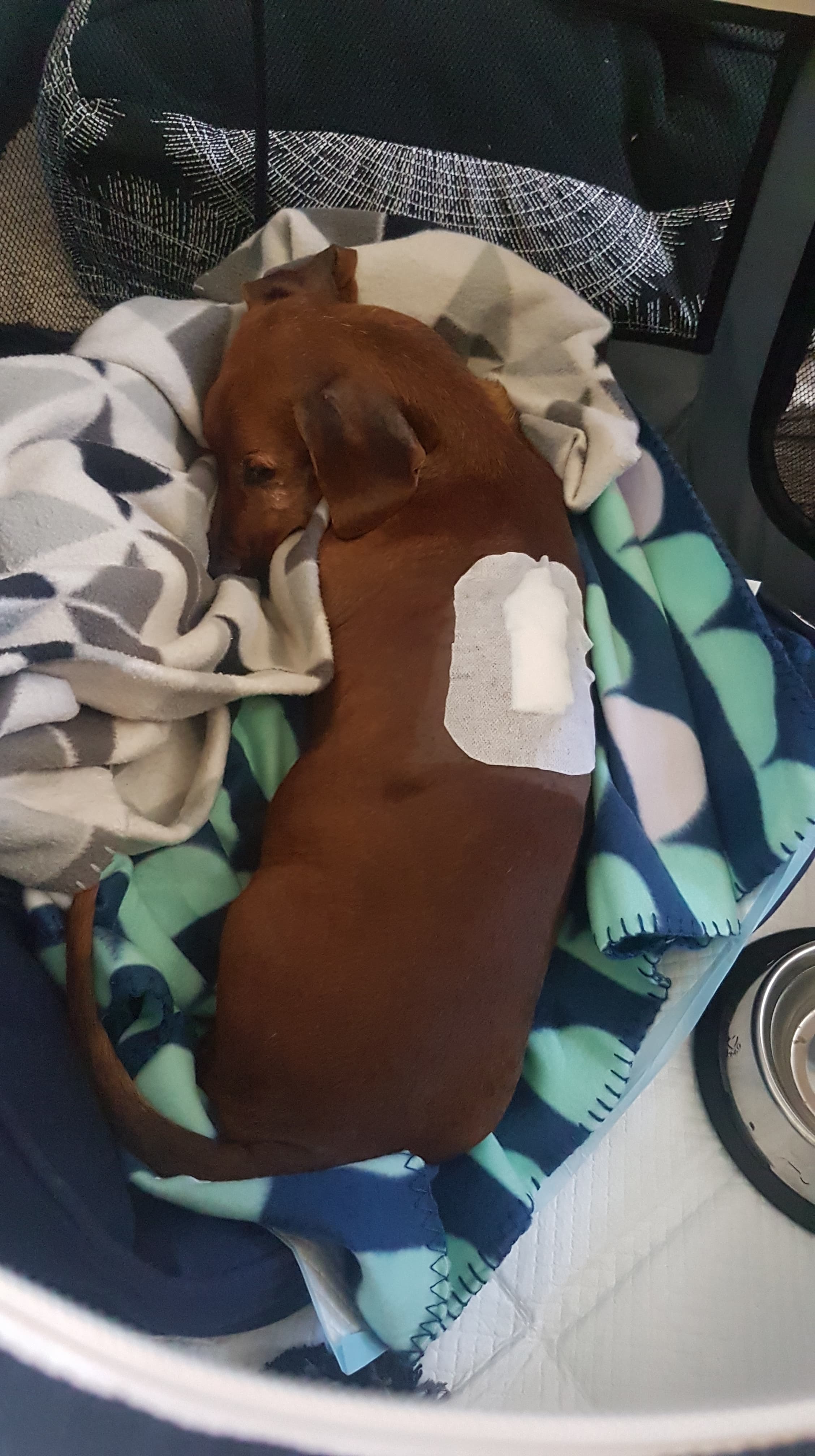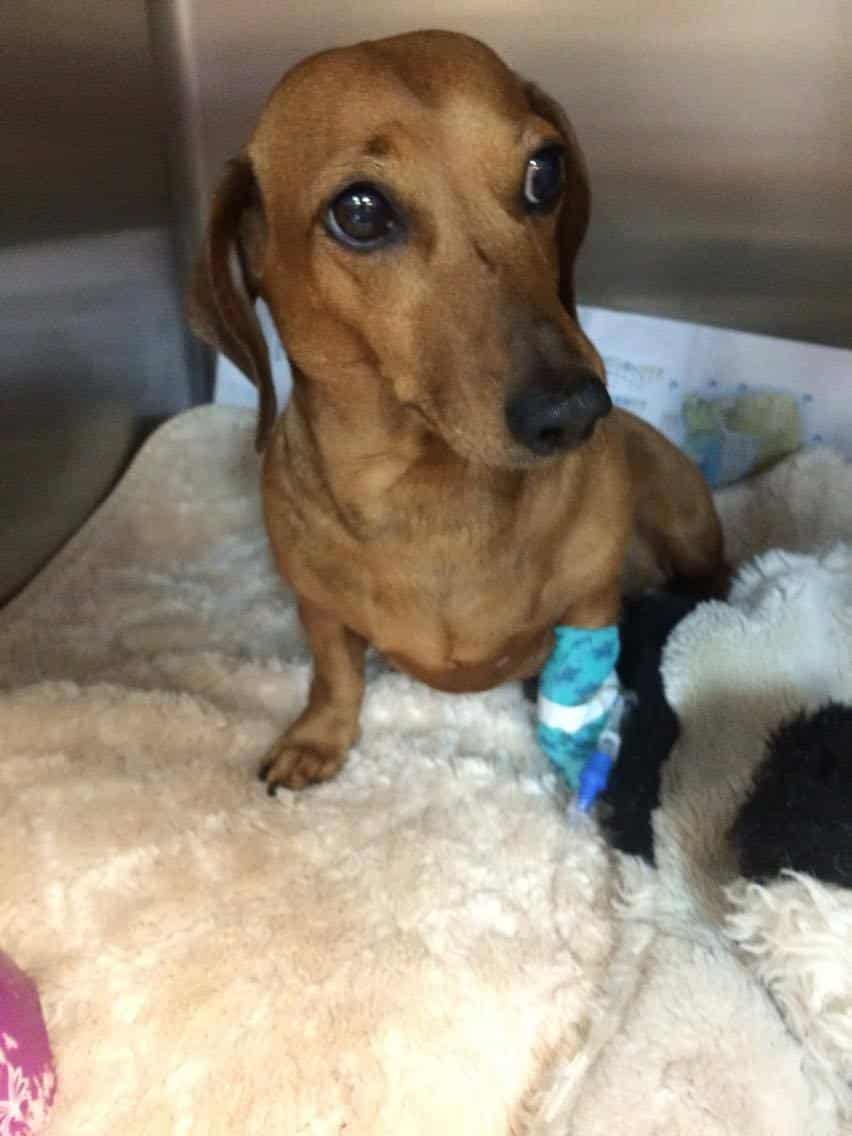If following a thorough neurological assessment it has been determined that surgery would provide the best prognosis to help your dog get back up on all four paws, read on as “we’ve got your back”.
What has happened to my dog?
Well, your dog has just been diagnosed with IVDD, Intervertebral Disc Disease; a genetic disease which now affects 1:4 dachshunds.
What does this mean? It means that in some area of your dog’s spine, surrounding the vertebrae, calcification has developed around the discs. This has now caused pressure on the spinal cord, and as a result, has manifested itself in showing the signs and symptoms that your dachshund was displaying.
These symptoms would have been categorised, and your dachshund would have been diagnosed anywhere from Stage One, being the least affected, to Stage Five, where complete paralysis was evident.
Click on the button below for the different stages of IVDD and prognosis
Why did my dog need surgery?
The reason your dog has required surgery is, after a thorough neurological assessment with the specialist vet, it was felt that surgery would provide the best prognosis to help your dog get back up on all four paws and walk again in the future.
The procedure is done to clear out and clean out any spinal debris which surrounds the herniated disc applying pressure to the spinal cord.
Sometimes the surgeon also puts a window into the vertebral disc, known as fenestration, to avoid future re-occurring episodes.
It sadly is not unheard of that some dachshunds require two (or more)lots of surgery, should the first one not be successful.
Unfortunately, once a diseased spine always a diseased spine.
Visiting your dachshund after surgery & what to expect
It’s always a very anxious period seeing our beloved dachshund soon after surgery.
The clinic will allow you to visit your dog as soon as they feel it is appropriate for your dog.
When you go to see your dachshund, you will note that they may well be quite drowsy. This is due to all the sedation after surgery, as well as the medication they have been given to help with the pain of surgery.
When you first see your dachshund, the most visible thing you will see is a shaved back, and a sutured incision down their backs. At first glance it can be frightening to see. But the healing deep down within has started to begin. Don’t worry, that wound will heal and their hair will grow back. It just takes time.

Some dachshunds also have visible tubes when you go and visit. One could be an intravenous drip, which is normally located in one of their front paws. This helps to keep them hydrated after surgery while they are recovering.
Most dogs don’t have an appetite for drinking and eating after surgery, so the drip stays in until your dachshund wants to enjoy drinking and eating again. With most dachshunds we know it usually doesn’t take long, as they love their tucker.
Some dachshunds also require a catheter to help them pass urine, especially if they are taking some time to regain deep pain sensation. Catheters normally stay in until a dog regains movement.

Once your dog’s movement returns, bladder and bowel function soon follows. But don’t panic if your dachshund takes longer for them regain bladder function, as the staff at the hospital will teach you how to express their bladders if function is slow to return.
Put quite simply, all the above is very normal for the few first days (or more) after surgery so no need to panic, it’s all part of the recovery process. But do bear in mind, all specialist centres are different in their approach to surgical cases.
How long will my dachshund be at the hospital?
All surgical cases are different and it depends on the functionality / responsiveness of your dog after surgery, which determines how long your dachshund will remain at the vets after surgery.
Each dog is an individual and they vary in response to their recovery, so no one rule fits all. You will be guided by your specialist on how long your dachshund will stay.
IVDD recovery requires time and lots of patience.
Preparing for coming home – what you will need
It’s essential that after surgery that your dachshund is confined to a crate/pen, as it is exactly what they need to allow nature to do its work and allow your dachshund to heal.
It is paramount for this to be done to ensure maximum recovery. They are still fragile, and a lot of the swelling and inflammation needs to settle down, which requires patience and time. So make sure you make that doggie boudoir nice and comfortable and cosy, as this is going to be home for your dachshund to heal in the coming weeks.
- Crate (recovery suite). It is highly recommended that you opt for a metal crate. 36” is a good size. Many owners have commented that soft crates are easily chewed and destroyed as well as they do not offer your dog good visibility. Metal crates can be set up on wheels and wheeled around and they can also be safely put on top of a coffee table etc. This allows your dogs to feel a part of the family and relieves stress for both dog and owner! Don’t forget to cover the crate with a sheet to make it feel snuggly and safe.
- Sturdy (unescapable) pens – remember dachshunds are Houdini’s! The set up at the bottom of this page is a great example of a recovery suite.
- Sling (to prevent dragging and assist your dog to toilet) PS Make sure you pop your dog on a lead as well. Can be items such as GingerLead Support Sling (available on DISA Shop), Pantyhose/Tights, Dressing gown cord or a Green Shopping Bag with the sides cut out. (Refer to the link below for further info)
- Pee pads
- Belly bands for boys
- Baby wipes (for accidents)
- Lots of towels.
- Polar fleece squares
- Diapers for incontinence
- A wheat pillow or doggy hot water bottle.
- Change table or similar to save your back!
- A good orthopaedic type mattress for the crate. Should not be too soft.
- A water bowl for the crate (attached to the side) which is raised high enough so that your dog does not need to bend down to it.
- Pet stroller – just make sure your dog is securely harnessed and avoid 4WDing on the rough roads for a while. These have been found to be a godsend for most owners.
- Infra-red anti-barking devices have been found to help in some cases.
- Kongs filled with treats (non-fattening). Remember we are trying to keep our dog at a good weight to avoid stress on its back.
- Adaptil Diffuser. A synthetic analogue of canine appeasing pheromone, which has a comforting and reassuring effect on your dog
- Enrichment treats such as LickiMats.
- Calming “supplements” or pharmaceuticals for anxious hounds – speak to your Vet/Specialist.
Click on the buttons below for further information
The crate is your mate!
If your dog has never been crate trained before, there is a good chance he or she is going to give you that typical dachshund “I am not impressed, I hate you and there is absolutely nothing wrong with me” look.
Also, we humans are prone to feeling more regretful and upset about the whole event than our dogs. But don’t be fooled. Crate rest is exactly what your dachshund needs in order for nature to work its magic and let the healing process to begin.
We recommend a 36″ wire crate (dachshunds are great escape artists!), comfy crate pad, nothing too soft or spongy. Remember, your dog has had back surgery and will need lots of support to heal.
Lay an absorbent easily washable material underneath your dog; bath mats and towels are handy for this. You may even need lots of towels, as they do appear to go through them quickly. Include their favourite blanket and toys, anything to keep them occupied.
A water bowl attached to the side of the crate, enabling easy access and less spillage. Coop cups are great for this purpose.
You may also find, if your dog is wearing a ‘cone of shame’ when coming home, the coop cups are also the perfect size for them to reach the water and can also be used as a feeder bowl.
Lots of pee pads are also helpful, as the dogs do tend to have some accidents, especially if they are starting to regain bladder and bowel function. It’s best to set a pee pad up at one end of the crate, so they can get to it easily when needed.
Click on the button below for further information
Physiotherapy & Therapies
If you don’t use it, you lose it. It is highly recommended to seek advice from allied service providers (eg: physiotherapy, hydrotherapy, acupuncture, laser treatment) as soon as possible following surgery.
During the first few weeks after surgery, you will be advised that your dachshund will most importantly need crate rest, especially in the first few weeks, to allow the surgical area to heal.
There will be a lot of inflammation deep down, and this takes time to heal.
But it is most important once you are back home, that you contact a rehabilitation centre so that you can ensure your dog’s rehab is supervised by a canine physiotherapist.
They will guide you with what exercises and massage you need to do, to ensure your dachshund has the least muscle wastage while healing. They are the best to guide you in what to do, and we have been advised that contact with a rehabilitation specialist should occur within 2 days of having had surgery.
We cannot emphasise the importance of rehabilitation enough to ensure that your dachshund has the best chance of getting back up on all four paws again.
Whilst this is a brief guide to surgery and what will be expected you must be guided by your specialist and the rehabilitation professional, as each dachshund progresses differently after the surgery.
Click on the button below for further information
Drugs 101
Your veterinary surgeon/specialist will have prescribed your dachshund medication to help him / her get by in the following weeks after surgery. Remember not all drugs are right for every affected dog. Work with your veterinarian to determine the best drug, dose, and schedule for your own dog.
ASK YOUR VET/SPECIALIST ABOUT THE RISKS AND SIDE AFFECTS – GOOGLE ALL MEDS SO YOU HAVE AN UNDERSTANDING.
The types of pharmaceutical drugs that may be prescribed are –
- Steroids
- Anti-inflammatories
- Pain relief
- Sedatives
